Whether you are a fan of the theatre or not, it’s not hard to see the importance of theatres. Not only are they are gateway to the arts for those who wish to enter that world, but they can be considered vital to the economic and cultural development of a city. They create jobs, bring people into the city and can boost a city’s economy as a whole. Furthermore, a theatre, especially an older one, can be a base of historical significance.
This year, thirty theatres have been placed on the Theatre Trust’s Theatres at Risk Registrar, illustrating that there is plenty of work that needs to be done to some of this country’s greatest historical entertainment venues. In order to shine a light on these beautiful old buildings, I decided to do a little bit of digging and learn a bit more about them.
The theatres at risk are catagorised by three factors which a score of between one and three being given for this. These scores are then combined to create an overall risk rating.
Community value – which assess the communities demand for a theatre and the viability of the building once again being used as a performance venue
Star value – an assessment of the building’s architectural quality and workability as a theatre.
Risk factor – assesses the risk to the building from demolition, development, alteration or decay.
You can read about the ten theatres featured in part one of Theatre’s at Risk, History At Risk here
Burnley Empire

The 1200 capacity Burnley Empire was built in 1894, with it’s auditorium resigned and reconstructed by Bertie Crewe in 1911. With it’s high level of architectural interest, it was awarded grade II listing. Although the theatre is in a bad way, it is believed that it could be restored.
The theatre has been closed since 1995, when it stopped being used as a bingo hall. In 1997, it was found that the upper level was showing signs of severe water damage and over the last year there has been a number of break ins, on of which resulted in a rather large fire.
In 2015, the building went up for auction and many were concerned at any buyer would choose to demolish it but it was saved by the Burnley Empire Trust at the last moment. Whilst this is a god sign, there is still a lot of work to do to restore the Empire to it’s former glory.
Community value – 2
Star value – 2
Risk factor – 3
Risk rating – 7
The Palace Theatre Plymouth

Originally called the New Palace Theatre of Varieties, this theatre was built in 1898 and operated through to 1961 when it was converted into a bingo hall. It was briefly used as a live performance venue again until 1983, when it then became the Dance Academy and was used as a dance and night club until 2006 when it was closed down when class A Drugs were found on the premises. Since then, the Palace Theatre has stood abandoned.
With it’s nautical themed decor and adjoining Great Western hotel building that is also on the Heritage at risk register, it is believed that the Palace could be restored back to it’s former glory but with the Theatre Royal Plymouth just down the road, many believe that it is no longer needed. Work has been carried out to make the building water tight, but since this was done in 2015, photographs have shown that the interior continues to deteriorate. The area in which the theatre stands is a part of the city that is targeted for regeneration with the hope that the theatre could become a community and music venue in the future.
You can read more about the Palace Theatre Plymouth (which just so happens to be on my doorstep) here
Community value – 2
Star value – 2
Risk factor – 3
Risk rating – 7
Hulme Hippodrome, Manchester
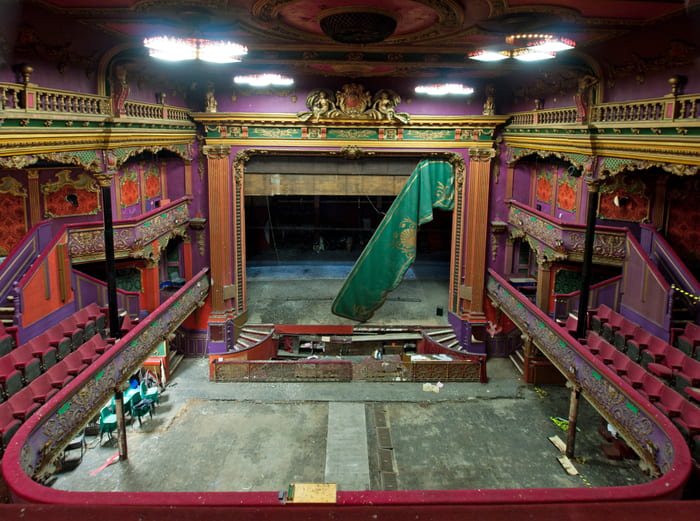
The Hulme Hippodrome opened in 1901 boasting a large 2000 seat auditorium and grand decor, and is now considered to be of vital cultural, historical social importance. It was last used as a theatre in the 1960’s and was re-purposed as a bingo hall but the mid 1970’s until 1986. An evangelist group purchased the building in 2003, but only used the foyer meaning that the rest of the theatre was left to fall into a state of disrepair. The owner was served a dangerous buildings notice in 2017 and it has been completely empty ever since.
The areas surrounding the theatre has been going through a large regeneration project and it is believed that the theatre could be made use of as part of these projects with the council keen to find a historic led sustainable long term use for it. Squatters were removed from the premises in 2018 but the building remains empty and in urgent need of restoration.
Community value – 1
Star value – 3
Risk factor – 3
Risk Rating – 7
Century Theatre, Coalville
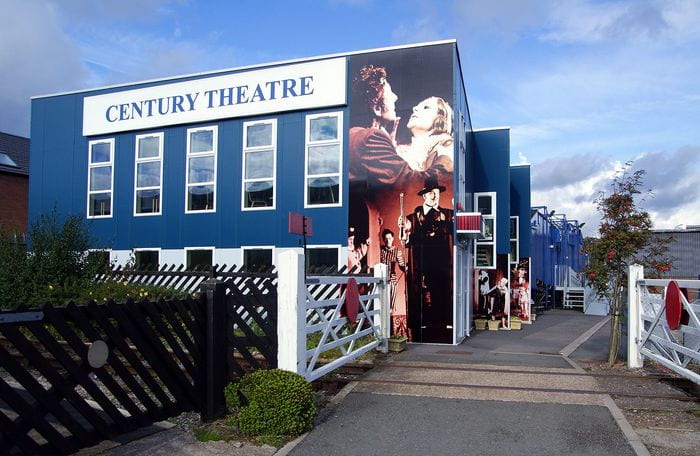
Constructed after World War Two as a unique mobile venue, the Century Theatre toured the country as 4 forty foot trailers comprising of a stage, dressing rooms and an auditorium with fixed seating. The purpose of this travelling theatre was to build interest in the arts and 17 cities it visited built their own theatres as a result. It was moved up and down the country for 23 years before settling in Keswick where it was nicknamed the Blue Box.
In December 1996, it was moved one final time to the Snibston Discovery museum in Coalville where it is used as a permanent performance space and museum. The museum was closed and partially destroyed in 2016 and whilst the theatre still stands, developments near by threaten the venue with the space wanted for residential purposes.
Community value – 3
Star value – 2
Risk factor – 1
Risk rating – 6
The Granada Theatre – Walthamstow

Built as a cinema and variety theatre in 1930, through it’s lifetime the Granada theatre in Walthamstow was used as a live music venue with performers including The Beatles and The Rolling Stones. With grand decor that was refurbished in the mid nineties, the building closed in 2003 after the then multi screened cinema went out of business.
In 2014, a pub company re-purposed the foyer as a bar and used one of the two smaller screens as a small scale entertainment venue and continued to do so until January this year. Waltham forest council now have plans to restore and reopen the building to it’s full potential. Whilst the outlook for the Granada looks positive, there is still a lot of work to do.
Community value – 3
Star value – 2
Risk factor – 1
Risk rating – 6
Leith Theatre

Opened in 1932, the Leith Theatre boasts a large performance space with a horseshoe shaped balcony and vaulted ceiling. The theatre closed as a large scale performance venue in 1988, and although pop up events are still sometimes hosted there, a lot of work is needed to restore it fully.
The future is looking good for the Leith Theatre, but with the project relying on council and trust funding, things are still fragile.
Community value – 3
Star value – 2
Risk factor – 1
Risk rating – 6
Kings Theatre, Dundee
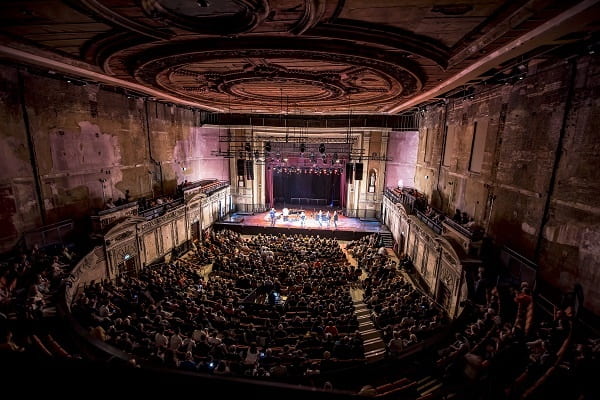
Originally boasting lavish interiors decked out in mahogany and teak and rococo style plaster work, The Kings Theatre in Dundee has been through a lot. Development work in the fifties resulted in the balcony being partially destroyed and a false ceiling being put in. It was used as a theatre until 1982 before being used as a bingo hall then a night club. After these activities ceased, an investigation into the building state established that it could be restored as a performance venue.
The ground floor is currently being used as retail whilst the rest of the building has been used over the years as nightclub rooms and snooker halls. If the building was restored to it’s full potential, it could be a huge financial asset to the city.
Community value – 3
Star value – 1
Risk factor – 2
Risk rating – 6
Tottenham Palace Theatre
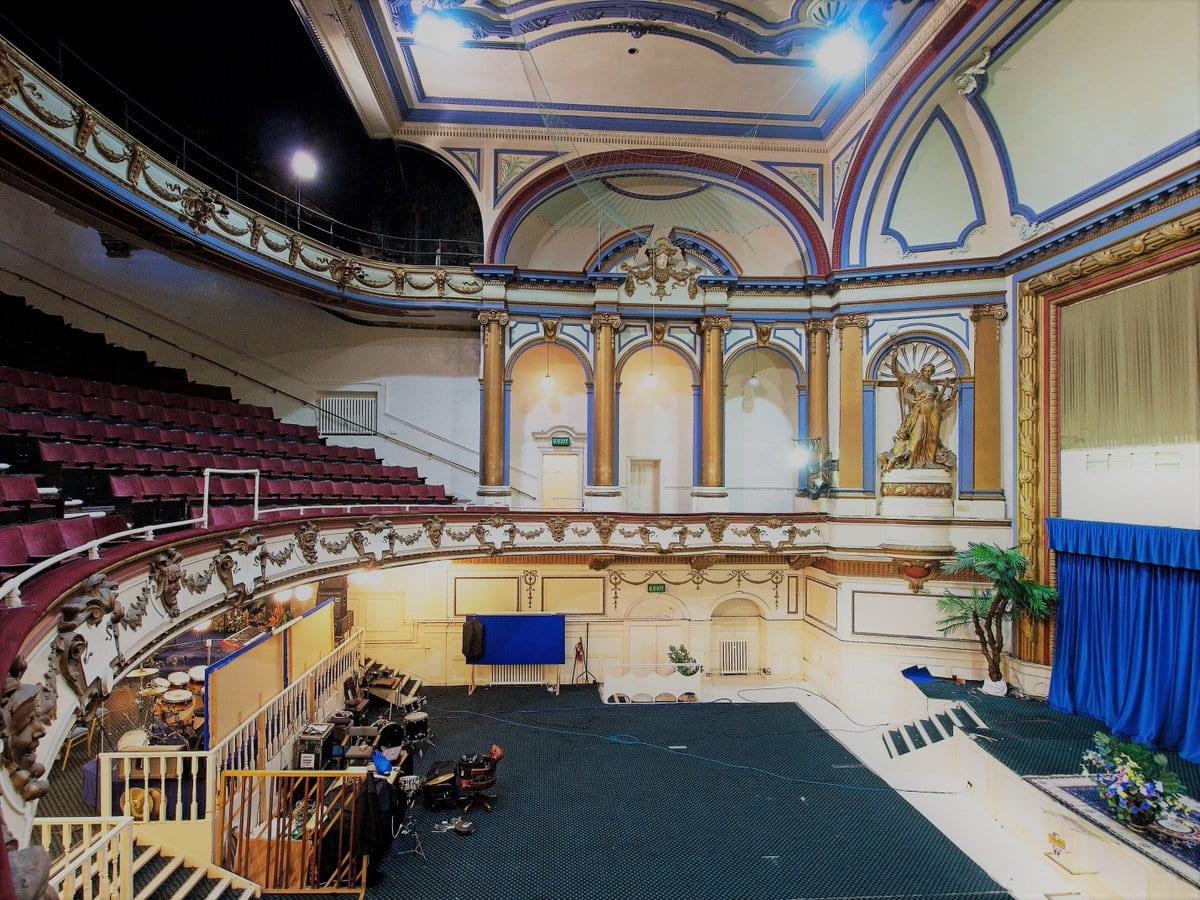
Built in 1908, The Tottenham Palace, this buildings life as a fully fledged theatre was rather short lived with it being converted to a cinema in 1926 then into a bingo hall in 1969. Very little was changed in terms of the interior with most of the original features remaining. In 1997, the building changed purpose once more and was converted into a church and it continues to be used as a place of worship today.
The theatre was placed on the at risk register in 2006 following the discovery of water damage in the building and whilst work was done in 2010 meaning that the building was taken off of the register, it’s now back on the list with plenty of work still needing to be done.
Community value – 2
Star value – 2
Risk factor – 2
Risk rating – 6
Conwy Civic Hall
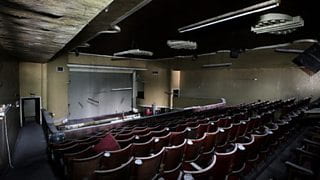
Conwy’s only theatre stands in it’s civic hall, sitting 240. Whilst deemed to be of importance to the community, the venue closed in 2014 and has since faced an uncertain future. It was open to commercial bids in 2016 and when it failed to sell it was then placed on the open market.
Conwy is currently without a venue for entertainment and meeting space with the library that stood in the civic center closing in 2019, leaving the building empty.
Community value – 2
Star value – 1
Risk factor – 3
Risk rating – 6
Mechanic’s Institute, Swindon

Originally opened in 1855 with lecture and refreshment rooms, the Mechanic’s Institute in Swindon was an important social hub. Converted into a theatre in 1930, it was a pretty building with an impressive stage and a fly tower.
The theatre was closed in 1986 and since then has fallen into a great state of disrepair. The Mechanic’s institute trust has been campaigning to turn the building back into a cultural hub for mixed entertainment and was granted charity funding in 2018. Although the future looks good for the institute, there is a lot of work to be done still.
Community value – 2
Star value -1
Risk factor – 3
Risk rating – 6
